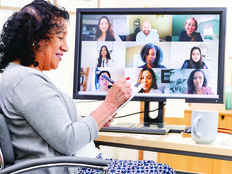Feds, FirstNet Build Public Safety LTE Network
When two pressure-cooker bombs exploded near the finish line of the Boston Marathon on April 15, 2013, local police, firefighters and emergency medical technicians joined with state and federal officials to respond to the attack. They issued alerts, warnings and information and gathered tips, videos and photos through social media.
The bombings “illustrated a rapidly changing landscape for emergency communications,” Rear Admiral Ronald Hewitt testified during a November 2014 hearing of the Congressional Subcommittee on Emergency Preparedness, Response and Communications. Hewitt, director of the U.S. Department of Homeland Security’s Office of Emergency Communications, told those present that the event involved “not just traditional land mobile radio use by first responders, but also citizen communications and increased use of broadband or Internet technologies.”
OEC had spent years helping Boston’s public safety community improve emergency communications prior to the marathon. As it works today with the First Responder Network Authority (FirstNet) to build the nation’s first interoperable public safety broadband network, the coordinated, multifaceted response to the Boston Marathon serves as a model for what could one day be possible nationwide.
Several federal agencies, including DHS and the Department of Commerce, have played a central role in planning the national public safety broadband network.
The number of responses — totaling 3,000 pages — to FirstNet’s request for information, which will feed the draft request for proposals for the network; 83 responses came from industry, 39 from state and local agencies and trade associations
SOURCE: TJ Kennedy, acting general manager, FirstNet
‘The Internet for Public Safety’
“We’ve made great progress over the last year on engaging with federal agencies,” says TJ Kennedy, FirstNet’s acting general manager. In August, FirstNet hired a full-time federal outreach liaison, Chris Algiere, to meet with federal agencies and learn about their needs and goals for the project.
The network will operate on the nationwide 700-megahertz spectrum and be built with long-term evolution (LTE) wireless technology. It will allow first responders from local, regional, tribal, state and federal agencies a unified view of a situation as it unfolds, sharing data, images, video and voice communications.
“The public safety community really rallied for this network,” FirstNet spokesman Ryan Oremland says. “This is like the Internet for public safety.” FirstNet’s philosophy has been to build on existing infrastructure, manpower and expertise rather than start from scratch.
“With federal coordination, we’ve been careful not to create something that already exists,” Oremland says. “Instead of building everything, we’re leveraging.”
Team Development
DHS is a natural partner for FirstNet, thanks to past work the agency has done with state, local and federal agencies to build coordinated emergency communications capabilities, but also because it has one of the largest federal responder user bases and likely will rely heavily on the completed network.
FirstNet has worked closely with two DHS programs, both administered by OEC, to further interoperable public safety communications. SAFECOM brings together state and local first responders and public safety associations, and the Emergency Communications Preparedness Center includes 14 federal departments and agencies.
FirstNet’s own Public Safety Advisory Committee, created to provide information and advice as it develops the network, consists of several members of DHS’s SAFECOM.
“When we meet with the Public Safety Advisory Committee, we meet with them for a day, and then they’ll go meet with SAFECOM and OEC for a day, because it’s a lot of the same members,” Kennedy explains. “We’re trying to be cost-effective by sharing space and travel costs.”
FirstNet itself has spent much of the past year building its own capacity — hiring staff and opening headquarters in Reston, Va., as well as a technical office in Boulder, Colo. It is also working toward objectives set by its March 2014 strategic roadmap sessions, including consulting with states about their public safety needs and network requirements; initiating a public notice and comment process on program procedures and policies; and releasing draft requests for information on what FirstNet should consider as it prepares requests for proposals.
“I’m quite excited to say that we’ve been hitting those milestones and making terrific progress,” Kennedy says.
Setting the Standard
FirstNet has relied on the Department of Commerce’s Public Safety Communications Research (PSCR) program to prepare standards for the network. Long before FirstNet was created, PSCR began exploring the idea of using LTE broadband technology to supplement the land mobile radios commonly used by first responders, and it has spent several years working with the Third Generation Partnership Project, a global standards organization, to get public safety requirements into the LTE standard. PSCR created a test bed in Boulder so that it could work with manufacturers and vendors to deploy products in the laboratory, research the technology and ensure it could meet the requirements of the public safety community.
“By the time FirstNet was formulated, we had a great deal of hands-on experience around LTE,” says Dereck Orr, program manager for PSCR, a joint program of the Department of Commerce’s National Institute of Standards and Technology and National Telecommunications and Information Association. “We had strong industry participation, and we had a long history of working with the public safety community.”
Because of the progress PSCR had already made, FirstNet provided it with funding to continue work on the stand-ards. Public safety relies on three capabilities in land mobile radios that PSCR is now working to get into future LTE standard releases: direct-mode (devices to communicate with each other directly rather than going through a cellular tower); group communications (several responders to communicate at once); and push-to-talk (one person speaks to many with the push of a button).
Last year, FirstNet increased funding to PSCR to further research on three additional capabilities — priority, preemption and quality of service. All are important to public safety and already in the LTE standard but have never been deployed in commercial networks. Those capabilities would designate priority users, allow them to preempt other users by downgrading their services, and establish quality of service parameters to guarantee that high-priority users can access the service they need.
“It allows the most important people on the scene access to the bandwidth they need to respond to an event,” Orr explains.
In addition to the standards work, PSCR has modelers and simulators in Gaithersburg, Md., who have been showing FirstNet what a nationwide network could look like. For instance, simulations could explore whether rural areas are best served by higher-powered devices that reach farther as opposed to adding more cellular towers, or whether it makes sense to invest in weatherproof sites or put up lower-cost overlapping sites to provide greater redundancy.
“Even though the network isn’t deployed, you could do the what-ifs and ask, ‘What happens if I lose this site, and this site, and this site, and I’ve deployed this kind of grid pattern? Do I still maintain my expected communications capability?’ ” Orr says. “It’s not what you’re going to see when you actually build the network — because the real world never matches up to a model — but at least it’s going to give you a way to understand how things might play out.”
FirstNet Primer
FirstNet planners are working hard to ensure a national public safety network is in place soon to assist first responders. Some milestones and facts about the project:
- FirstNet was established by the Middle Class Tax Relief and Job Creation Act of 2012 to create a nationwide public safety broadband network.
- FirstNet is an independent authority within the U.S. Department of Commerce’s National Telecommunications and Information Administration.
- FirstNet’s 15-member board includes the secretary of Homeland Security, the attorney general, the director of the Office of Manage- ment and Budget, and 12 other members with expertise in public safety, broadband and telecommunications networks from both the private sector and government.
- The legislation that established FirstNet allocated $7 billion for the network through the Federal Communication Commission’s wireless spectrum license auction, held in November 2014.








